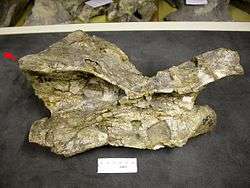Australodocus
| Australodocus Temporal range: Late Jurassic | |
|---|---|
 | |
| Cervical vertebra | |
| Scientific classification | |
| Kingdom: | Animalia |
| Phylum: | Chordata |
| Class: | Reptilia |
| Clade: | Dinosauria |
| Order: | Saurischia |
| Suborder: | †Sauropodomorpha |
| Clade: | †Neosauropoda |
| Family: | †Diplodocidae |
| Subfamily: | †Diplodocinae |
| Genus: | †Australodocus Remes, 2007 |
| Species: | †A. bohetii |
| Binomial name | |
| Australodocus bohetii Remes, 2007 | |
Australodocus, meaning "southern beam" from the Latin australis "southern" and the Greek dokos/δοκоς "beam", is a sauropod dinosaur that lived during the Late Jurassic period, around 150 million years ago in what was then German East Africa (now Tanzania). Its scientific name is derived from it being considered a southern (Gondwanan) relative of Diplodocus. The species name honors Boheti bin Amrani, a native crew supervisor and chief preparator who was an important contributor to the German expeditions that first excavated the Tanzanian sites. [1]
The remains of Australodocus bohetii were recovered from the Tendaguru beds of Tanzania, which have been a fertile ground for many Jurassic dinosaurs, including several genera of large sauropods, such as Giraffatitan (also known as Brachiosaurus brancai), Janenschia, Tendaguria, and Tornieria. Australodocus itself is based on two neck vertebrae, which are less elongate than those of other diplodocids and differ in other anatomical details. These vertebrae were originally part of a series of four vertebrae collected in the 1909 expedition led by Werner Janensch; like some other fossils collected by German expeditions to Africa, the other bones were destroyed in World War II. The 2007 description of the surviving bones increases the known diversity of sauropods and diplodocids in Tendaguru.[1]
Australodocus was originally described as a diplodocid, because it had double (bifurcate) neural spines on some of its vertebra, a characteristic normally associated with diplodocoid sauropods. However, several later studies by John Whitlock and colleagues found that Australodocus is actually a member of the sauropod clade Titanosauriformes, possibly closely related to Brachiosaurus. The presence of a higher number of macronarian sauropods in the Tendaguru environment compared to numerous diplodocoids in the Morrison Formation may be due to previously known differences in environment, with the Tendaguru being dominated by conifer forest, and the Morrison being dominated by open plains of low-browse flora.[2][3] In 2015, a study conducted by Emanuel Tschopp and colleagues recovered Australodocus as a Diplodocine Diplodocid, closely related to Supersaurus and Dinheirosaurus.[4]
Size
Gregory S. Paul estimated in 2010 its length at about 17 meters and weight at just 4000 kg.[5]
References
- 1 2 Remes, Kristian (2007). "A second Gondwanan diplodocid dinosaur from the Upper Jurassic Tendaguru Beds of Tanzania, East Africa". Palaeontology. 50 (3): 653–667. doi:10.1111/j.1475-4983.2007.00652.x.
- ↑ Whitlock, John (2011). "A phylogenetic analysis of Diplodocoidea (Saurischia: Sauropoda)". Zoological Journal of the Linnean Society. 161: 872–915. doi:10.1111/j.1096-3642.2010.00665.x.
- ↑ Whitlock, J.A. (2011). "Re-evaluation of Australodocus bohetii, a putative diplodocoid sauropod from the Tendaguru Formation of Tanzania, with comment on Late Jurassic sauropod faunal diversity and palaeoecology". Palaeogeography, Palaeoclimatology, Palaeoecology. 309 (3–4): 333–341. doi:10.1016/j.palaeo.2011.07.001.
- ↑ "A specimen-level phylogenetic analysis and taxonomic revision of Diplodocidae (Dinosauria, Sauropoda)". PeerJ. Retrieved 2015-12-07.
- ↑ Paul, G.S., 2010, The Princeton Field Guide to Dinosaurs, Princeton University Press p. 189 - 190.